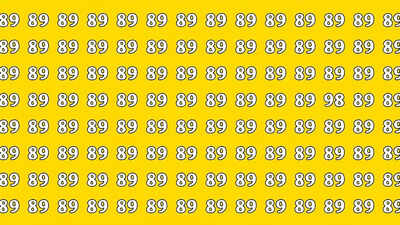ARTICLE AD BOX

In an exam copy, what makes you happier-89 or 98? The answer is universal and simple: 98/100 gives an immense opportunity to flex, right? Just like in an exam copy, in this optical illusion that same ‘98’ is going to make you relive that feeling of joy.
At first glance, it’s just a wall of 89s, right? But wait-nothing else? Hidden among them is a single 98. Sounds easy? Not so fast! Most people need more than a quick glance to spot it. But if you can find it in under 5 seconds, it says a lot about your attention to detail and brain speed. Ready to test yourself
Where is the 98?
- Step 1: Split the screen into four parts.
Mentally draw a big plus sign to create top-left, top-right, bottom-left, bottom-right zones.Why this helps: compressing the search area lowers cognitive load (as by doing this ,you’re scanning 25% at a time), reduces back-tracking, and keeps your eyes from darting randomly.
- Step 2: pick one quadrant and scan.
Start, for example, at top-left. Scan left to right across the first row, drop down one line, then right to left. This keeps your gaze anchored and ensures you don’t skip clusters.

Credit: Canva
- Step 3: filter for just one feature-the right-hand digit.
Every “89” ends with 9. You’re hunting the only pair that ends with 8. So, ignore the first digit and let your eyes skim only the second digit of each pair. Look for the two closed loops of an 8 instead of the stick-and-loop 9. This single-feature search is much faster than reading both digits each time.
- step 4: confirm the oddball.
When you spot a pair where the right digit is 8, you’ve found it: 98. Pause, double-check the pair to its left and right, and enjoy that mini dopamine hit.
Answer:
The number 98 is located in row 5, column 3.If you start counting from the top as row 1 and from the right as column 1:Go down to the 5th row from the top and move to the 3rd column from the right. There you go-did you find your 98?

How are you with visual crowding?This puzzle falls under what’s called a visual search or ‘odd-one-out’ illusion.
It uses something known as visual crowding, which happens when similar items are placed so tightly together that spotting the different one becomes much harder. The trick isn’t really about fooling your eyes-it’s about testing how well your attention and pattern recognition work in a cluttered environment.What does this puzzle do for your brain?This little number hunt is more than just fun-it’s a workout for your brain. First, it sharpens your focus by training you to lock onto one tiny detail (the 98) while ignoring all the distracting 89s around it. It also boosts your visual scanning speed because you start to search systematically-row by row or block by block-making your eyes faster and more efficient. And here’s the best part: it reduces mental overload.
Instead of staring at a giant wall of numbers and feeling overwhelmed, your brain learns to break it into smaller chunks, making the search easier and more organized.



.png)
.png)
.png)
















 1 hour ago
3
1 hour ago
3









 English (US) ·
English (US) ·